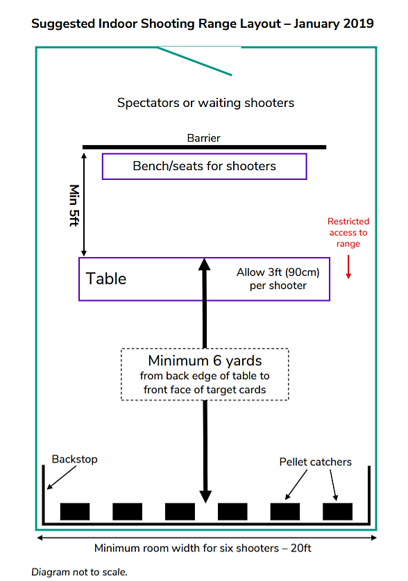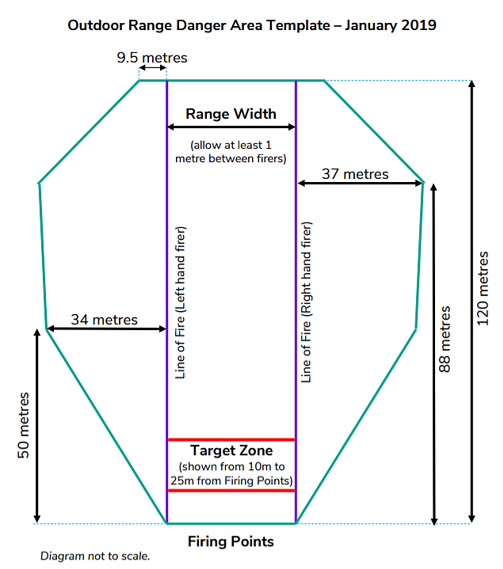Equipment and Range Layout
Equipment and Range Layout
Types of target
Most target shooting is carried out using paper targets. For most disciplines the targets have circular aiming marks and concentric scoring rings, but other geometrical designs may be encountered and are acceptable for Scout use.
Using targets representing humans or animals is not permitted as a part of any Scout activity, nor on property owned or leased by, or used in the name of, the Scouts.
Modern purpose built airgun and small-bore ranges may have electronic target systems where the scoring is achieved automatically, displayed on the firing point and printed at a central console.
There are also a number of types of reactive targets available for airgun shooting.
These will generally fall when hit providing instant feedback to the shooter and to spectators. They are available as sets of targets in a box or frame intended for indoor use or as individual targets suitable for Field Target shooting. Both types of target are available in geometric shapes and can be used in line with the relevant range construction guidelines.
The Construction of Airgun Ranges
Airgun ranges used by Scouts or on Scout premises must have been properly constructed to comply with the guidelines issued by the National Small-Bore Rifle Association (NSRA) or the National Rifle Association (NRA) and with any bye-laws relevant to the location of the range. These guidelines originate from the criteria for Airgun Range Construction contained within the Ministry of Defence Joint Services Publication 403 Volume II.
The following notes are intended for the information of those who may be asked to authorise the construction of a range on premises under their control and for Range Officers whose training and qualifications relate to firearms other than airguns. The main danger specific to airgun shooting is the risk of pellets bouncing back from striking a hard or reflective surface near the target area.

Notes:
- This diagram is indicative only.
- 6 yards is the minimum distance for safe airgun shooting.
- Security of the area in front of the firing points is vital. Any doors in front of the shooters‘ table must NOT be capable of being opened from the outside.
- It's desirable to have a separate area where shooters may be briefed before entering the range.
On indoor ranges each target will be mounted in a holder with a pellet catcher designed to trap the pellet and to withstand repeated impact. The range should be constructed with a backstop to prevent damage to walls and fixtures from the occasional shot that misses the target holder and pellet catcher.
Safe backstop materials are those which either:
a) Totally resist the pellet, causing it to lose all its energy in deforming; eg heavy steel plate or a thin steel sheet mounted directly in contact with a rigid material such as chipboard.
b) Decelerate the pellet and dissipate its energy; eg loosely hanging sheets of carpet or heavy canvas (which may be made even more effective by suspending two pieces about three inches (70mm) apart.
c) Allow initial penetration followed by deceleration and expansion; e.g. a combination of materials forming a sandwich, such as hardboard/carpet/chipboard and hardboard/expanded polystyrene/chipboard.
Note: Backstops using either design b or c must be inspected regularly as they will deteriorate in use.
The following materials are generally NOT safe to use on their own for the reasons shown:
- Hardboard – penetration
- Thin steel sheet – penetration
- Chipboard – vicious rebound
- Timber (hardwood) - vicious rebound
- Timber (softwood) – unpredictable rebound.
Purpose made pellet catchers and target holders are commercially available and their use is recommended. However, acceptable temporary target holders can be made from large cardboard boxes filled with newspapers, magazines, bits of carpet, etc.
A properly constructed airgun range should not have a significant rebound hazard. Ranges that do, must not be used. Therefore there should be no need for shooters or range staff to wear eye protection.
A newly constructed range must be tested for rebound before being used by young people and the test must also be repeated after backstop renewal. During testing, eye protection must be worn.
Air pistols have a lower permitted energy limit than air rifles. The lower pellet energy means that rebound (instead of penetration) is more likely from certain types of backstop. Ranges where air pistols are going to be used must be tested for rebound with air pistols as well as air rifles. Distances between firing points and targets can also have an effect as can well-worn guns with reduced pellet speeds.

Notes:
- The entire Danger Area must be secured and should be overseen by the Range Officer.
- The original template in the Code of Practice is expressed partly in angular units and is shown here converted to wholly linear units for the convenience of users.
- Lines of Sight must be below the horizontal (ie targets below muzzles)
- These dimensions relate to horizontal ground.
- Note that the Range Danger Area extends 120 metres from the Firing points.
- Down-range distances increase if the ground falls beyond the targets and may be reduced if the ground rises beyond them. (These effects are small unless the rise or fall is very substantial).
- If all Lines of Sight are parallel, The Danger Area width is:
- equal to the Range Width plus 68 metres at 50 metres from the Firing Points
- equal to the Range Width plus 74 metres at 88 metres from the Firing Points
- equal to the Range Width plus 19 metres at 120 metres from the Firing Points.
Take care when laying out this template near to the boundary of the property where you have permission to shoot. Falling pellets beyond 120 metres from the firing point do not have a significant risk of injury, but an air pellet can travel up to 300 metres and it is an offence to shoot beyond your boundary.
Outdoor airgun ranges may be constructed either with or without a stop butt. For those with a stop butt, similar rebound considerations apply as for indoor ranges. In addition, the absence of a roof could allow an accidental shot at high elevation to go over the top of the stop butt and consideration should be given to operating a full danger area template.
Equipment
Calibre
POR Rules concerning airgun shooting other than as an activity of a Home Office Approved club specifically limits calibre to .177 inch or less, except outdoor shooting at a club range for Field Target purposes when .22 inch calibre may be used.
The reasons for this are as follows:
- For target shooting at paper targets a standard calibre is used to enable fair competition (all pellets make similar sized holes); .177 inch is the internationally recognised calibre for this purpose.
- The maximum permitted muzzle energy for air rifles not requiring a Firearms Certificate is 12 ft/lb, regardless of calibre. .22 air rifles are generally made with muzzle energies near this limit so that they are most effective against live quarry. The muzzle energy of a .177-inch air rifle designed for target shooting at 6 yards or 10 metres may be around half this value.
- A typical .177 pellet will lose its energy through aerodynamic drag more quickly than a .22 pellet of the same muzzle energy. This means that over longer distances a negligent loose shot with a .177 pellet presents a lesser hazard.
Pellet type
POR also specifies that the pellets used must be ‘diabolo shaped’ and of soft deformable metal such as lead; flat head pellets are the standard used in target shooting competitions. This is to minimise the risks of bounce-back from the target area. Tests have shown that pellets of some other types, notably steel BB and plastic Zaps, rebound badly from traditional steel target boxes.
Security
It's a legal requirement to keep airguns and ammunition secure when they are not in use. Unsupervised access by young people must be prevented. This will involve keeping airguns under lock and key when not in use.
For permanent storage in an HQ or campsite a dedicated and robust cupboard or other container fixed in a permanent lockable building is recommended. Its purpose should not be apparent from the outside. It is good practice to store airguns and pellets separately. Only those over 18 should be allowed access.
Where there is no practicable alternative to short term storage in vehicles, guns and pellets should be hidden, preferably in a separately locked area of each vehicle, such as a car boot. If a choice of several vehicles is available, choose those with alarms fitted.